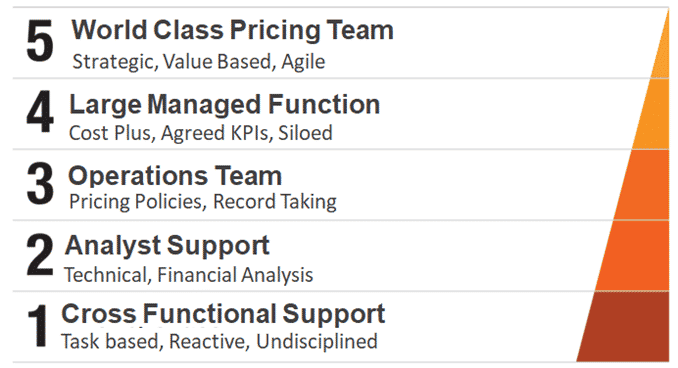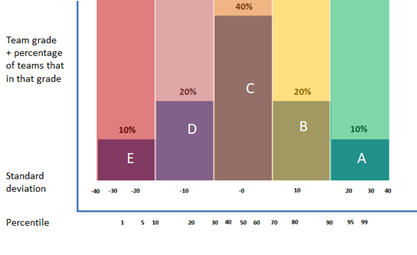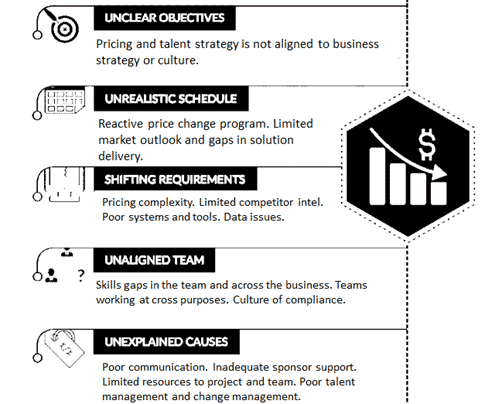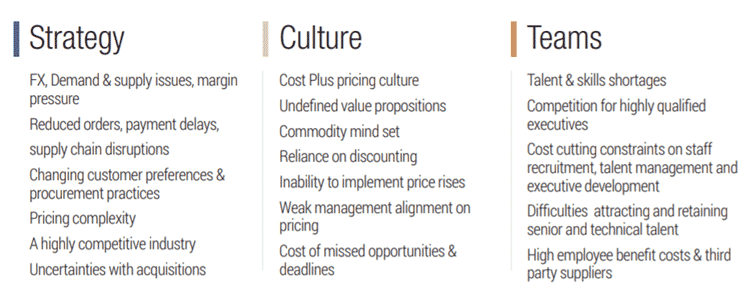
Many CEOs say they haven’t really considered building a dedicated pricing team to drive their price management strategies because they’ve already got a finance team managing their money and a sales team bringing in sales revenue. Maybe they should.
>Download Now: Free PDF Future Proof Your Pricing Strategy
A whole raft of new pricing reports from leading consultancy firms, representing thousands of publicly listed companies in Australia and around the world, find that businesses with a dedicated pricing team and infrastructure not only generated 3 times the return on investment in years 1-2, and 7 – 10 times return on investment in year 5 but also sustained a long-term price advantage of roughly 15 to 25 per cent of a typical company’s total profits.
This could be millions of pure profit dollars for your company.
Not bad for a team that pretty much no one seems to know much about or even heard of.
No surprise either – your competitors don’t want you to find out because they’ve got a pricing team working against you right now.
Table of Contents:
I. Price Management Strategies: World-Class Pricing Teams Generate 10X Industry Profits
II. Price Management: Why Winning Teams are an Illusion
Capability Building Programmes For Pricing & Sales Teams!

Price Management Strategies: World-Class Pricing Teams Generate 10X Industry Profits
Pricing teams are one of the best-kept secrets in business for a reason.
A world-class pricing team is your company’s no 1 profit driver; giving you a major advantage in an increasingly margin pressured industry.
So, in this article, I’m going to reveal how one of the best-kept price management strategies and secrets in Australia (a pricing team) keeps accumulating more revenue and more margin than any other team in the business – no matter how turbulent the economic environment is.
I will also explain how much additional margin a pricing team can generate compared to a sales or finance team managing price and how they do it.
What is a world-class pricing team?
A pricing team is quite unlike the traditional finance, and marketing departments we all know or even the large, cost-plus pricing function that you may have encountered or heard about in your career.
A world-class pricing team is quite rare because of it:
- Generates 7- 10 times more profit than any other team using the latest pricing strategies, models and analytics
- Accelerates learning & buy-in to new ways of thinking about Price Management Strategies, Pricing, Revenue Management, Customer Value & Customer Demand
- Protects the business from ongoing margin pressure and risks like these
If you’ve never heard of a pricing team before, don’t worry, we’ll discuss this in more detail later. If you have heard of a pricing team and haven’t got one yet, then what type of pricing support are you using right now to manage your pricing?
Not sure? No problem. Listed below are the 5 most common teams setting and managing pricing in leading Australian businesses today.

Each of the team you see on this list generates different levels of EBIT (which means earnings before interest and tax). Not all teams are like world pricing teams, and most teams are struggling to achieve their full potential to drive profit in highly competitive and intense markets.
Here’s why you need a world-class team to drive your price management strategies…
The type of team you design and set up to manage your pricing will largely determine how much dollar value you’ll get out of your pricing management strategies.

In fact, our research indicates that your team’s ability to drive profit using the latest pricing strategy is capped by who’s on the team and how the team has been set up in the first place.
How Many Pricing Analysts Do you Really Need? 👩💼 Podcast Ep. 40!
Our key findings on pricing teams to date are:
- Admin support teams updating price files and lists lose on average c.3 per cent margin each year. Largely due to skills gaps and mistakes.
- The average margin improvement generated by average pricing teams is c.0.25-1.0 per cent each year. This group’s revenue-generating capability tends to be capped by organisational design, pricing policy and team capability issues.
- The average margin improvement generated by world-class pricing teams is 3 – 7% per cent each year. This group generates substantially more revenue and margin for businesses because the organisation has invested equally in strategy, people and operations.
That’s right. A world-class team generates millions of pure profit dollars each year without risking your hard-earned revenue and volume. And, not just because they use fancy pricing systems. No, because the strategy and culture in which they operate support and understand their mission.

So how do world-class pricing teams make more money than other teams even when markets are tough?
A world-class pricing team is like no other. They are small, agile teams made up of highly specialised pricing skills, styles, views, experiences and mindsets.
They are positioned in the business to mobilise the power of teams to get work done and achieve more complex business outcomes. Break down large, complex pricing projects into smaller, safe price actions and lots of small incremental EBIT gains that are of value even when stand-alone.
They decrease margin erosion by providing a 3, 6, and 9 months outlook on the market and take low-risk fully informed price actions that generate profitable revenue growth across the product portfolio and customer segments.
Price management strategies: What do most teams managing pricing do?
They are large, siloed and slow-moving managed functions made up mostly of accountants, and commercial and financial analysts. Have a fixed view on pricing – applying overly complex cost allocation calculations. They focus on working out their costs and use overly simplistic mark upon cost or cost plus to set margins.
Financed-based pricing teams can often ignore the #1 source of pricing power: your customers and your staff. It is common to find these teams creating multiple sign-off procedures that delay price decision-making across the business and frustrate other teams.

Taylor Wells Advisory Firm strongly believes that a full-time, world-class pricing team that knows price management strategies is now required to stop pricing chaos
A world-class pricing can help you drive consistent and safe earnings growth in good times and in tough times. A team that can manage all these challenges; (listed below) while generating an additional 3 – 7 per cent margin each year.

But we’re not saying a world-class pricing team is your silver bullet solution to all your problems.
No. Actually our people analytics and pricing research across 17 different industries, 130 businesses and 2084 executives indicate…
- That even world-class pricing teams fail in a toxic culture.
- That one toxic person on the team does, in fact, stop a pricing implementation in its tracks
Pricing Recruitment For Pricing Managers!
Based on our evidence and experience, we believe that the best price management strategies to generate more revenue and more margin during your transformation are as follows:
ADAPT YOUR APPROACH TO HIRING
Hire the right mix of skills, styles, and capabilities for the pricing team using a bit more science.
EMPOWER YOUR TEAMS
There is no better way to maintain a world-class pricing team; than to make sure that each and every team member has the tools, skills and knowledge. To make fully informed pricing decisions.
WORK ON YOUR CULTURE
Create a clear, test-and-learn pricing culture. Make sure all teams are aligned to pricing strategy during key stages of implementation and see learning as part of their job.
CREATE A NEW PRICING TEAM STRUCTURE
Design leaner teams and new pricing roles that align with business strategy and culture. Use a practical and proven pricing framework to guide executives through the complexities of pricing team design and decision-making.
DEPLOY NEW TALENT SOLUTIONS ACROSS THE EMPLOYEE LIFE CYCLE
Implement a talent management system designed for pricing and revenue management teams. Compared to sales or finance, pricing is a relatively new functional area. Pricing is also an evolving discipline. Many of the competencies and behaviours that are used to measure talent, pay, and promotion opportunities are no longer relevant to pricing teams. Because pricing work is changing so quickly.
Price Management Strategies for the Digital Age
Technology now plays a key role in shaping price management strategies. Companies that adapt to these changes can better meet customer expectations, maximise profits, and stay competitive.
Digital tools like AI, data analytics, and pricing software transform pricing processes. For example, a retailer might use AI to track competitor prices and adjust its own in real-time. This ensures competitive pricing while maintaining profit margins. Data analytics also helps businesses understand customer behaviour. A restaurant could use data to identify popular menu items and adjust their prices to match demand.
Automation simplifies routine pricing tasks. Online marketplaces often use automated tools to update prices instantly, saving time and reducing errors. This allows teams to focus on strategic pricing decisions.
However, human oversight remains essential. While technology improves efficiency, pricing must still reflect a business’s unique goals and brand identity. A local furniture store, for instance, might combine pricing software with staff input to ensure prices align with customer expectations.
Successful price management strategies in the digital age also require collaboration. Sales, marketing, and technology teams must work together to create a unified approach. Regular reviews and updates to pricing strategies ensure they remain relevant as market conditions change.
In essence, businesses that blend digital tools with human insight gain a competitive edge. Adopting flexible and responsive price management strategies enables companies to meet customer needs while achieving sustainable growth. The key is to balance technology’s efficiency with a strategic focus on long-term goals.
〉〉〉 Get Your FREE Pricing Audit 〉〉〉
Implications
As you can see, investing in a million-dollar pricing strategy is a waste of money. That is if you don’t have the right people, talent management and organisational team structures in the place first. Pricing implementation failure is mistaken as a strategy problem, when in fact it’s a people and culture issue.
If you are going through a top-down strategic transformation largely driven by price optimisation software and a new segmentation; better hiring, people analytics and talent management are also critical factors for executing pricing strategy and building a value-based culture.
Learn how you could obtain a 7-10 times return investment on your price management strategies in year one.
Capability Building Programmes For Pricing & Sales Teams!

Price Management 💲: Why Winning Teams are an Illusion
In price management, everyone loves a winning team. But based on how most companies work, business culture doesn’t really support or encourage teamwork. That’s why teamwork is sometimes a misnomer.
A team is only as good as its weakest link.
When your top players don’t know how to work together, their individual talents are useless. Ego is sometimes the killer in a team. That’s the price companies pay when they reward individuals rather than collective achievements. The weakest link breaks when individualism takes over.
There is the notion that working in teams gets the job done. But is this really the case? Do teams really put out more creativity and production as we assume? Can teams really overcome commercial challenges as well as many leaders like to believe they can?
Most of the time, teams fail miserably at solving new problems and getting the job done. Team members struggle to get a consensus on what the team should be doing. Agreeing to what the team is supposed to do is the leader’s job. Great leaders, particularly price managers, are always willing to risk, both their personal lives to get the job done and their professional reputation to be a good leader, to drive the team’s objectives. If the leader or the pricing manager isn’t skilled or determined enough to manage and set up the team properly, strategy and team goals are bound to fail.
Research
Richard Hackman, the Edgar Pierce Professor of Social and Organisational Psychology at Harvard University and a leading expert on teams, claims that research has shown that most teams do not get the job done properly.
Even with vast resources at their disposal, a lack of coordination and motivation can eat away at the collaborative efforts of the team. Team members tend to think they own a project; and when everything is set up for the unveiling, the leader changes course at the last minute and changes everything with little explanation or concern.
What Is A Chief Revenue Officer And What Should They Know About Pricing 🧑🏼💼 Podcast Ep. 110!
In order to build a world-class team, leadership needs to be authentic, promoting collective rather than individual achievements.

Here are some of the most common reasons why teams don’t work and how you can address these challenges:
- The purpose is vague
If a team has no inkling what their purpose is, how can they be successful? It’s essential to lay out a clear vision as well as key objectives for the team to focus on. It’s also important to assess team skills – strengths and areas for development – right from the outset. Then monitor if and how all team members have played their part in achieving shared goals and objectives.
- No leader
A team without a genuine and dedicated leader often has no direction. However, it doesn’t mean the leader is making all of the decisions for the team. Instead, their role is to act as a coordinator for the team. This role may entail delegation, multi-tasking and scheduling, etc.
- Too Many Cooks in the Kitchen
Ever heard the expression ‘Too many cooks spoil the broth?’ The same is true for teams. In fact, having fewer members on a team is more effective than more. Harvard professor J. Richard Hackman, recommends team numbers shouldn’t be in the double digits. Forming teams like sub-committees; with people who are passionate about what they do, and have the skills and competence to achieve team goals is essential.
- Inconsistent Membership
It should be clear who really belongs to the team. Leaders shouldn’t just invite everyone to participate for fear of someone “feeling left out”. Generally speaking, the more time members work together, the better they perform together.
- Fear of “Rocking the Boat”
Hackman’s research investigated the role of the devil’s advocate on team performance. They compared two teams: teams that produced something original and teams that were merely average – i.e., teams that produced very little and or had team members that didn’t really stand out in any way. It turned out that the teams with devil advocates outperformed teams without them.
In many cases, deviant thinking is a source of great innovation.
Every team needs a devil’s advocate, someone who can help the team by challenging the tendency to maintain the status quo. Complacency and acquiescing to the status quo destroy creativity, diversity of thought and learning. In other words, you need someone on the team who’s going to be the devil’s advocate. That’s also applicable to the pricing manager career, they challenge the norm. Give the team more difficult goals to achieve success.
The devil’s advocate is far from an ordinary team member profile – and at great personal cost. People who deviate from accepted and often subconscious team norms are the people who are willing to say the things that nobody else will say. And everyone else was too scared to point out.
Sometimes people who take a risk can raise other people’s level of anxiety. But conscientious and well-intended risk-taking is a courageous thing to do. Nobody on the team wants to hear the awful truth, which is precisely why many team leaders frown on team members who ‘rock the boat.’
More often than not, teams do not ask difficult questions; and for those that do, they are commonly removed from the team and cast off as ‘troublemakers’. And yet it’s when you lose the devil’s advocate from the team, the team gets stale, stagnant and eventually underperforms.
Pricing Recruitment For Pricing Managers!
Why Smart Price Management Strategies Focus on Customer Perceived Value
Smart price management strategies revolve around understanding customer perceived value. This approach helps businesses set prices that reflect what customers feel is worth paying. By doing so, businesses build trust, foster loyalty, and stand out in competitive markets.
For instance, focusing solely on covering costs or competing with others can lead to undervaluing unique offerings. A business that sells handmade jewellery might initially set prices based on material costs and competitor rates. However, when they highlight the craftsmanship, durability, and emotional significance of their pieces, customers may see greater value and willingly pay higher prices.
Moreover, communicating the “why” behind a product’s price strengthens relationships. Customers are more likely to invest in a service or product when they understand its benefits. Take a software tool designed for small businesses. Instead of just listing its features, explaining how it saves time, reduces stress, or increases productivity makes the value clear.
Offering options tailored to different customer needs is another effective strategy. For example, a fitness centre could provide tiered membership plans, from basic access to premium packages with personal training. This flexibility ensures customers find a plan that matches their budget and preferences, boosting satisfaction.
In the Australian market, adopting price management strategies that prioritise value is particularly important. Customers here increasingly seek meaningful benefits and expect businesses to align pricing with perceived worth. By focusing on value rather than price alone, businesses can create lasting connections and drive sustainable growth.
Ultimately, smart pricing isn’t about charging more—it’s about showing customers why your offering is worth it. When value drives the conversation, pricing becomes a tool for building trust, not just generating revenue.
Implications
- A good team will fulfil the needs of both internal stakeholders and customers. They can also become stronger as a unit as time passes; embedding, over time, new organisational norms like learning and growth within the team and wider organisation.
- Even the best leaders struggle to make a team perform well. There’s no guarantee or secret recipe for building a magical team. Teams create their own realities and control their own goals. A good leader establishes a clear vision and ‘gets the right people on the bus’ to implement the vision.
- Good and bad teams established norms far sooner than most team leaders realise. Getting team planning right from the start is essential to short and long term performance. Don’t let team dysfunction become your new norm.
- If the leader is not skilled enough to manage and set up the team, a strategy is bound to fail.
〉〉〉 Get Your FREE Pricing Audit 〉〉〉
Bottom Line
- Many leaders work under the notion of harmony. They believe that a team that gets along well with everybody is more productive than others. This is not true.
- Our research shows that a workplace without ‘dynamic tension’ is a false workplace. But managers still see tension as an energy that needs to be silenced and subdued.
- At Taylor Wells, we strongly believe that, when tension shows up in a team, leaders should harness and channel this energy to drive team performance. Don’t deny the natural energy of teams because it feels socially acceptable or uncomfortable.
A workplace without ‘dynamic tension’ is a false workplace.
- Conflict is the source of ‘dynamic tension’ in teams. Without tension and clear conflict resolution, teams can’t problem solve and don’t produce the results you want from them.
- Tension is what keeps your team and commercial function at the top of their game. You can learn to face them. Or ignore them until they creep up on you.
Click here to access your free PDF guide on driving pricing strategy in your business.
For a comprehensive view on building a great pricing team to prevent loss in revenue, download a complimentary whitepaper on Future Proof Your Pricing Strategy.
Are you a business in need of help to align your pricing strategy, people and operations to deliver an immediate impact on profit?
If so, please call (+61) 2 9000 1115.
You can also email us at team@taylorwells.com.au if you have any further questions.
Make your pricing world-class!

